UHZ1 is 13.2 Billion Light Years Away – It’s the Oldest and Most Distant Black Hole Ever Discovered

This image offers a glimpse of a black hole in an early stage of its development, just 470 million years after the Big Bang. The composite image shows data from NASA's Chandra X-ray Observatory and James Webb Space Telescope. It features scores of seemingly tiny celestial objects in a sea of black. This is the galaxy cluster Abell 2744. When magnified, the tiny white, orange, and purple celestial objects are revealed to be spiral and elliptical galaxies, and gleaming stars. Many of these colorful specks appear to float in a neon purple cloud of X-ray gas in the center of the image, some 3.5 billion light-years from Earth. Just to the right of center, at the edge of the purple gas cloud, is a tiny orange speck. This speck is far in the distance, well beyond the Abell galaxy cluster. It represents a galaxy 13.2 billion light-years from Earth containing a supermassive black hole. In this composite image packed with celestial objects, the tiny orange speck is easily overlooked. Therefore, the main image of the release is also presented fully labelled. In the labelled version of the image, a thin box outlines the distant galaxy, and two enlargements are inset at our upper left. In the enlargement showing Chandra data, a hazy, neon purple oval with a light pink core is shown. This purple oval represents intense X-rays from a growing supermassive black hole estimated to weigh between 10 and 100 million Suns. The purple oval is not visible in the composite image because of the way the Chandra data was processed. This black hole is located in the distant galaxy in the center of the enlargement showing Webb data. (Image Credit: X-ray: NASA/CXC/SAO/Ákos Bogdán; Infrared: NASA/ESA/CSA/STScI; Image Processing: NASA/CXC/SAO/L. Frattare and K. Arcand)
UHZ1 is 13.2 Billion Light Years Away – It’s the Oldest and Most Distant Black Hole Ever Discovered
X-rays imaged by NASA’s Chandra X-ray Observatory combined with infrared data from NASA’s James Webb Space Telescope were used to detect the most distant black hole ever discovered. The extremely distant black hole is located in the galaxy UHZ1 in the direction of the galaxy cluster Abell 2744, which was used as a gravitation lens in these observations. Abell 2744 is only about 3.5 billion light-years from Earth. UHZ1 is behind Abell 2744 and much farther away. At some 13.2 billion light-years away, UHZ1 is seen when the universe was only 3% of its current age. These new results may help explain how some of the first supermassive black holes in the Universe formed. It is believed that UHZ1 formed directly from the collapse of a huge cloud of gas rather than from the compression of a huge galaxy, which would not have had time to form this early in the Universe.
By using over two weeks of observations from Chandra, researchers were able to detect X-ray emission from UHZ1 — a telltale signature of a growing supermassive black hole in the center of the galaxy. The X-ray signal is extremely faint and Chandra was only able to detect it — even with this long observation — because of the phenomenon known as gravitational lensing that enhanced the signal by a factor of four.
The purple parts of the image show X-rays from large amounts of hot gas in Abell 2744. The infrared image shows hundreds of galaxies in the cluster, along with a few foreground stars. The insets zoom into a small area centered on UHZ1. The small object in the Webb image is the distant galaxy UHZ1 and the center of the Chandra image shows X-rays from material close to the supermassive black hole in the middle of UHZ1. The large size of the X-ray source compared to the infrared view of the galaxy is because it represents the smallest size that Chandra can resolve. The X-rays actually come from a region that is much smaller than the galaxy.
This discovery is important for understanding how some supermassive black holes — those that contain up to billions of solar masses and reside in the centers of galaxies — can reach colossal masses soon after the big bang. Do they form directly from the collapse of massive clouds of gas, creating black holes weighing between about ten thousand and a hundred thousand suns? Or do they come from explosions of the first stars that create black holes weighing only between about ten and a hundred suns?
The team of astronomers found strong evidence that the newly discovered black hole in UHZ1 was born massive. They estimate its mass falls between 10 and 100 million suns, based on the brightness and energy of the X-rays. This mass range is similar to that of all the stars in the galaxy where it lives, which is in stark contrast to black holes in the centers of galaxies in the nearby universe that usually contain only about a tenth of a percent of the mass of their host galaxy’s stars.
The large mass of the black hole at a young age, plus the amount of X-rays it produces and the brightness of the galaxy detected by Webb, all agree with theoretical predictions in 2017 for an “Outsize Black Hole” that directly formed from the collapse of a huge cloud of gas.
The researchers plan to use this and other results pouring in from Webb and those combining data from other telescopes to fill out a larger picture of the early universe.
The paper describing the results appears in Nature Astronomy and the authors include Akos Bogdan (Center for Astrophysics, Harvard and Smithsonian), Andy Goulding (Princeton University), Priyamvada Natarajan (Yale University), Orsolya Kovacs (Masaryk University, Czechia), Grant Tremblay (CfA), Urmila Chadayammuri (CfA), Marta Volonteri (Institut d'Astrophysique de Paris, France), Ralph Kraft (CfA), William Forman (CfA), Chrisine Jones (CfA), Eugene Churazov (Max Planck Institute for Astrophysics, Germany), and Irina Zhuravleva (University of Chicago).
NASA's Marshall Space Flight Center manages the Chandra program. The Smithsonian Astrophysical Observatory's Chandra X-ray Center controls science operations from Cambridge, Massachusetts and flight operations from Burlington, Massachusetts.
The James Webb Space Telescope is the world’s premier space science observatory. Webb is an international program led by NASA with its partners, ESA (European Space Agency) and the Canadian Space Agency.
For more information:
https://chandra.harvard.edu/photo/2023/uhz1/
https://www.astromart.com/news/show/nasa-reveals-james-webb-space-telescopes-first-images
https://www.astromart.com/news/show/cosmic-deja-vu-refsdal-supernova-reappears-exactly-as-predicted
https://www.astromart.com/news/show/something-big-is-lurking-beyond-the-visible-edge-of-our-universe
https://www.astromart.com/news/show/galaxy-cluster-smashes-distance-record
https://www.astromart.com/news/show/hubble-helps-physicists-find-double-einstein-ring
https://www.astromart.com/news/show/caltech-astronomers-find-the-most-distant-known-galaxies
https://www.astromart.com/news/show/caltech-swiss-team-discovers-first-ever-triple-quasars
Astromart News Archives:
https://www.astromart.com/news/search?category_id=3&q=.
Check out some of my favorite Words of Wisdom:
https://astromart.com/news/show/words-of-wisdom-my-favorite-quotable-quotes
https://astromart.com/news/show/words-of-wisdom-my-favorite-proverbs-from-around-the-world
Do you enjoy reading these postings?
Then click here and buy the Astromart staff a cup of coffee (and maybe even some donuts):
https://astromart.com/support-options
Funding Member
Sponsors
- Matsumoto Company
- ASTROPHOTOGRAPHY BY MARTIN PUGH
- OMI OPTICS USA LLC
- Anacortes Telescope
- AstroMart LLC
- BW
- astronomy-shoppe
- Rouz Astro
- SellTelescopes.com
- Bob's Knobs
- RemoteSkies.net
- BBLABS LLC
- FocusKnobs
- Desert Sky Astro Products
- Astromart Customer Service
- Waite Research
- APM-Telescopes
View all sponsors



